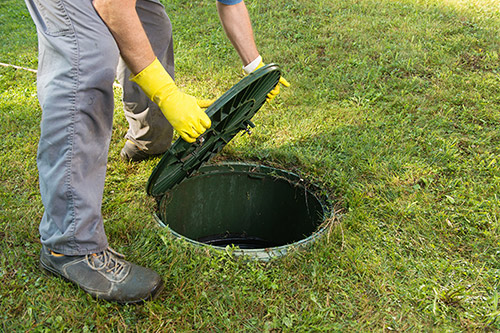
You may not think about your septic system that often because, gross. But septic neglect can cause major problems if you overlook the system for too long. Regular inspections and maintenance are vital for preventing costly damage to your tank and the surrounding area. It’s a good idea to have your septic tank inspected about every two to five years.
Can I Inspect My Septic Tank Myself?
It’s nearly impossible to inspect your septic tank yourself accurately. This is because a full inspection requires an experienced septic service professional. In some situations, you may need to have your septic tank pumped at the same time that you get it inspected. If it’s been a few years since you’ve last had your septic tank inspected, get in touch with a septic tank company near you to discuss your options.
How a Septic System Inspection Works
Understanding how a septic system works can be a bit tricky, especially if you’ve never owned a home with one before. Some homes are hooked up to a central sewer system that runs wastewater to a central processing facility. Not all homes have this capability. In particular, rural homes often use septic tanks that collect wastewater from your home and then disperse it into a drainage field. Because solids build up in the bottom of the septic tank, it needs to be inspected regularly and pumped every few years.
During a septic system inspection, inspectors will examine the septic tank, the septic distribution box, and the leach field. Inspectors will typically remove the lid of the tank in order to check the water level and make sure that water is flowing properly and that there are no leaks. They’ll also check the level of sludge in the tank to determine whether or not your tank needs to be pumped.
Routine Septic System Maintenance is Key
Proper septic system maintenance can help to prolong the life of your septic system and reduce the likelihood of unpleasant septic system-related messes. In addition to getting your septic system regularly inspected, you should also complete the following maintenance tasks to keep your septic system in good working order:
Be careful what you flush down the drain: Flushing items like sanitary products or bacon grease can back up your septic system.
Pay attention to bad odors: Your septic system does the hard work of breaking down household waste, but if it’s not working the way it should it can lead to some pretty unpleasant smells. Clogged drains, ice buildup, blocked vents, and a full tank can all lead to septic system odor.
Pump regularly: Depending on the size of your household and tank, you’ll need to pump the tank about every three to five years.
Without proper maintenance, you may be on the hook for a new septic system sooner rather than later. The cost of a new septic system is about $3,100 to $9,800. Costs vary depending on the type of system and size of the tank.
If you don’t pump your tank, the sludge builds up at the bottom of your tank will eventually leak into your leach field and back up into your pipes. Without regular pumping and maintenance, your septic tank could fail and need to be replaced. Ask your contractor whether additional maintenance is needed during your septic tank inspection.
For more information, contact Morse Engineering and Construction.
Souce: angi.com
